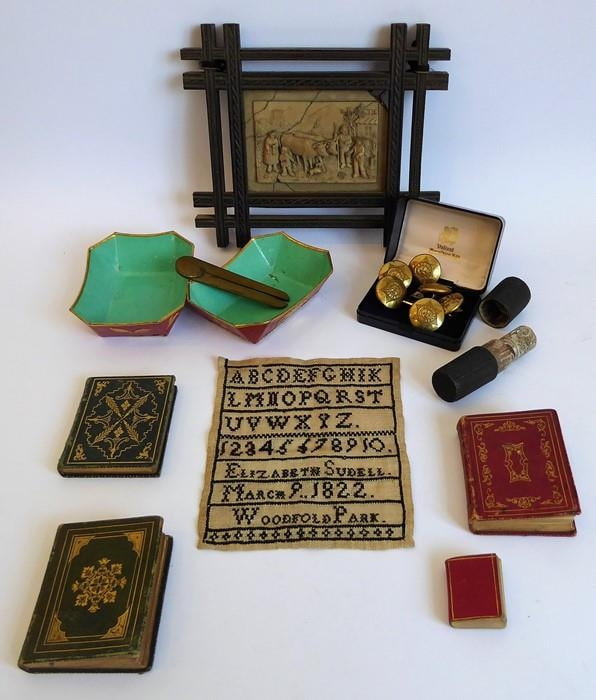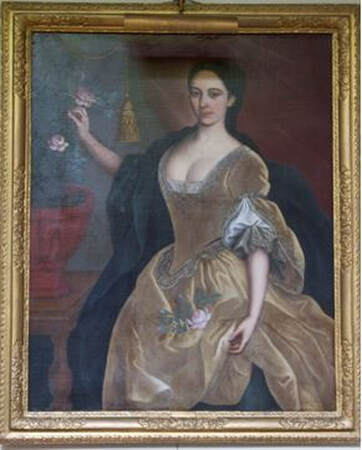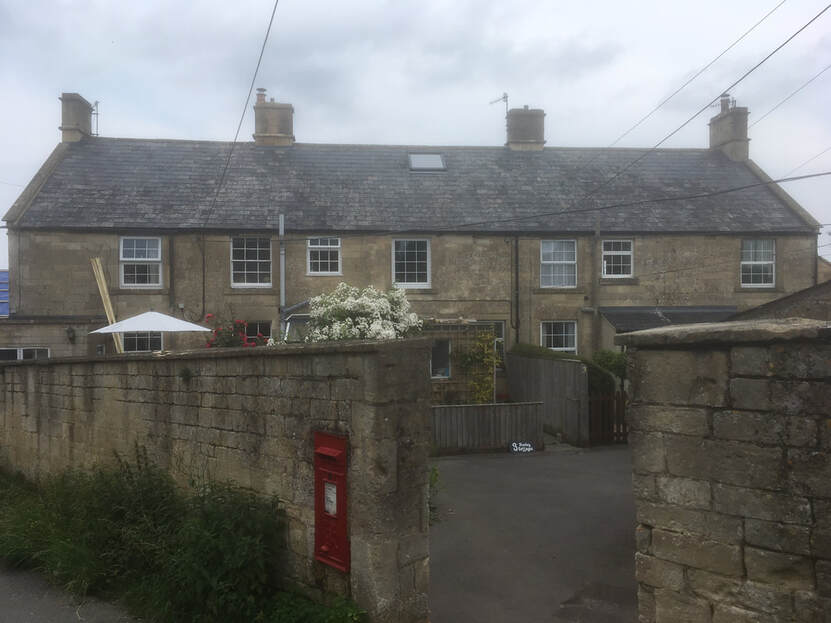Elizabeth Sudell Sampler Siân Coggins July 2021
A while ago I came across an article on your website concerning the Sudell family and the story had obviously made an impact somewhere in my grey matter as my “internal bells” started ringing on receiving a mailing concerning the sale of a needlework sampler.[1]
Amongst the various offerings from Tayler & Fletcher Fine Art, Bourton-On-The-Water, was a lot advertised as an interesting selection of bijouterie which made reference to the Sudells.[2] Listed amongst the articles were a sampler sewn by Elizabeth Sudell, aged 14, at Woodfold Park (sic) and books with handwritten dedications to Elizabeth Horlock from her daughter (dated 10 June 1850) and to Darrell Horlock from his sister (dated 1847).
I remember Box fairly well, having lived in Colerne during the early 1970s, which is possibly why the story of the Sudell family had caught my attention in the first place. My father was based at Lyneham from 1971 to 1973 and initially we were in quarters at Colerne before moving closer to Trowbridge for the remainder of that posting. Due to my father's job in the RAF, our family life was a wandering one for many years, the longest period of staying put anywhere was my early years in Anglesey, from where my mother heralded. These days sees me some way distant across the water in North Devon. My mother also had an earlier connection with the Box area, having left home after school to study domestic science in Bath, where her one claim to fame was a fellow student, a certain Mary Berry.
I cannot lay claim to being an expert in samplers, and sadly cannot afford to be a collector but, for the last couple of years, I have been on a hunt for a small Welsh one – hence the Sudell notification from the auction website. I do enjoy sewing and, with this particular type of needlework and I have a huge admiration for the ability of the stitcher, who may have worked incredibly small stitches in nothing other than candlelight. Sometimes some personal details are included within the piece and, if you are fortunate enough, you can discover a little of the background of the sewer. So many ordinary people just quietly disappear from our history and so it is lovely sometimes to be able to give the stitcher a voice and bring them back into the present times with their story, even if it is only attached to a piece of needlework.
It is difficult to comment too much on Elizabeth’s handiwork here as it’s online. This type of embroidery has a very long history and some European needlework samplers are at least 400 years old, demonstrating examples of different styles of lettering, types of stiches and a variety of threads. Sometimes they were created by middle-class women to record the forthcoming birth of a child, or as a way of marking the loss of a family member, or as practice pieces for young girls to learn skills of mend and make do. In the Victorian period, samplers in simple cross-stitch often repeated previously-bought patterns. They were used as pieces to teach letters and numbers to girls in home schooling, and for older children to record moral or Biblical quotations.
Amongst the various offerings from Tayler & Fletcher Fine Art, Bourton-On-The-Water, was a lot advertised as an interesting selection of bijouterie which made reference to the Sudells.[2] Listed amongst the articles were a sampler sewn by Elizabeth Sudell, aged 14, at Woodfold Park (sic) and books with handwritten dedications to Elizabeth Horlock from her daughter (dated 10 June 1850) and to Darrell Horlock from his sister (dated 1847).
I remember Box fairly well, having lived in Colerne during the early 1970s, which is possibly why the story of the Sudell family had caught my attention in the first place. My father was based at Lyneham from 1971 to 1973 and initially we were in quarters at Colerne before moving closer to Trowbridge for the remainder of that posting. Due to my father's job in the RAF, our family life was a wandering one for many years, the longest period of staying put anywhere was my early years in Anglesey, from where my mother heralded. These days sees me some way distant across the water in North Devon. My mother also had an earlier connection with the Box area, having left home after school to study domestic science in Bath, where her one claim to fame was a fellow student, a certain Mary Berry.
I cannot lay claim to being an expert in samplers, and sadly cannot afford to be a collector but, for the last couple of years, I have been on a hunt for a small Welsh one – hence the Sudell notification from the auction website. I do enjoy sewing and, with this particular type of needlework and I have a huge admiration for the ability of the stitcher, who may have worked incredibly small stitches in nothing other than candlelight. Sometimes some personal details are included within the piece and, if you are fortunate enough, you can discover a little of the background of the sewer. So many ordinary people just quietly disappear from our history and so it is lovely sometimes to be able to give the stitcher a voice and bring them back into the present times with their story, even if it is only attached to a piece of needlework.
It is difficult to comment too much on Elizabeth’s handiwork here as it’s online. This type of embroidery has a very long history and some European needlework samplers are at least 400 years old, demonstrating examples of different styles of lettering, types of stiches and a variety of threads. Sometimes they were created by middle-class women to record the forthcoming birth of a child, or as a way of marking the loss of a family member, or as practice pieces for young girls to learn skills of mend and make do. In the Victorian period, samplers in simple cross-stitch often repeated previously-bought patterns. They were used as pieces to teach letters and numbers to girls in home schooling, and for older children to record moral or Biblical quotations.
|
Elizabeth’s Sampler
According to your article, Elizabeth Sudell was born in June 1808 at Woodford Park, so she would have been 13 or 14 years old at the time she sewed this particular sampler. It appears to be a fairly small (14cms x 11.5cms), a straightforward piece with little in the way of embellishment or demonstration of stitch variation, but possibly not untypical of the period. The sampler seems relatively simple for a teenage girl but we don’t know the reason for its creation. Sometimes a piece of stitching might be dictated by the availability of cloth and / or threads, a particular school of sewing, such as the Quaker style, or trends when it was fashionable to stitch monochrome or fully black samplers. There are many examples online of greater skill demonstrated by girls aged 8 upwards - maybe Elizabeth was actually an accomplished seamstress and merely experimenting with the style of the day in this particular piece. Or possibly sewing was not her favourite pastime! |
Elizabeth died in 1858, aged 49, having experienced an eventful life. Her father Henry, a millionaire cloth merchant and manufacturer at Blackburn, Lancashire, went bankrupt in 1827 when she was 18. The family appears to have fled to France in disgrace and later returned to a rural retreat at Box, where the youngest child, 23-year-old Elizabeth, married the newly-appointed vicar, Rev Holled Darrell Cave Smith Horlock, on 30 October 1832. Elizabeth and Holled had two children, Elizabeth junior (1833-1921) and Darrell Holled Webb (1837-).
In 1851, Elizabeth and her older sister Alice established a charity girls’ school at Henley, Box. It was planned to cater for 70 girls, replacing the school operated at Springfield Villas (now called Spring Grove) by Mary Jane Mullins. Needlework would have been part of the education for young girls under the instruction of the Sudell sisters. In December 1857 Elizabeth and Alice contracted a mysterious illness after a Christmas meal, which killed them a few days later. Local residents believed their deaths were due to poisoning by Holled, about which John Suddell wrote in the article on your website. Elizabeth's life story was truly amazing.
In 1851, Elizabeth and her older sister Alice established a charity girls’ school at Henley, Box. It was planned to cater for 70 girls, replacing the school operated at Springfield Villas (now called Spring Grove) by Mary Jane Mullins. Needlework would have been part of the education for young girls under the instruction of the Sudell sisters. In December 1857 Elizabeth and Alice contracted a mysterious illness after a Christmas meal, which killed them a few days later. Local residents believed their deaths were due to poisoning by Holled, about which John Suddell wrote in the article on your website. Elizabeth's life story was truly amazing.


